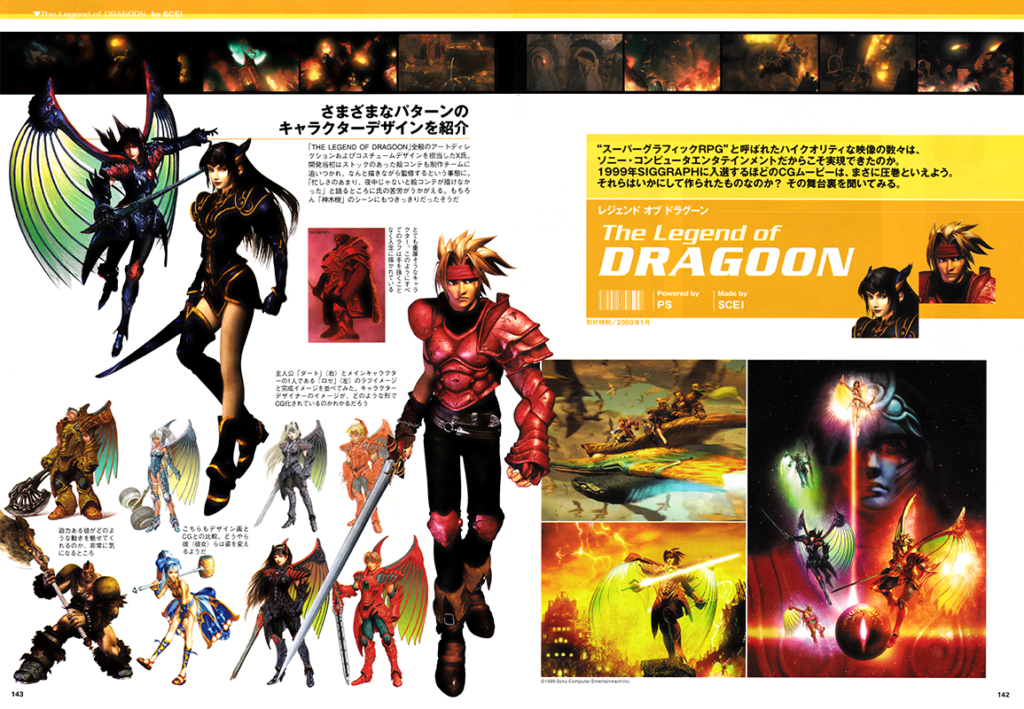A few weeks ago I ordered a CG World magazine, called “The Making of Game Graphics 1998-2001.” The Legend of Dragoon article within revolves around the technology used to make the game, but it also has some concept art that most fans haven’t seen until now! I just completed a basic translation of the article, so I’d like to share my findings with the global fandom.
**Note that this is a summary and not exhaustive. The full contents will be added to the community Resource Archive project at a later date, including higher-res images.

The first thing I’d like to bring up is the artwork on the opening pages. At first glance it looks like a set of common images we’ve already seen, like the renders of Rose and Dart. However on closer, professional inspection..

What!?

AAAHHHHHHHHHHHHH!!!!!!!!!!!
Now that we have the instant gratification out of the way – as though we aren’t going to be obsessing over these newfound images for awhile – I’d like to summarize the technology used in Legend of Dragoon along with fun facts.
One of the first things spoken about in the article, is storyboarding. Initially done by the art director, the storyboard responsibility was given to the production team under supervision. A quote reads: “I was so busy that I couldn’t draw the storyboards until midnight.” Even the rough concept art is carefully and meticulously drawn as seen above in the first row showing Kongol, Meru, Rose, and Dart.
Animation
Modeling and animation was done in part with Alias PowerAnimator. It is used for the pre-rendered FMVs or full motion video. The opening scene with the Great Commander is showcased.

3D objects could be painted on directly using StudioPaint3D. After applying the base paint, the art is refined by creating textures in Photoshop and applying them. Then the fully textured model is imported into PowerAnimator.

Motion capture is used for the knights in the opening sequence and some other cases, but for the most part keyframes are used to animate. At the time of this interview, in-house studios had a capture system called Motion Analysis. The motion used in all game titles – presumably for Playstation – was captured with the same system!

Some elements were also designed with another program called Houdini. This software was used for the Divine Tree cinematic. In order to maintain consistency of the rendering, RenderMan was used to balance the quality between the different rendering programs. Finally, a program called Inferno is used to composite the final output for use in the game.
Video Production
The process of producing CG video has three main parts. First, a story is written in a script style and drawn up in a storyboard. Then, the main scenes in it are raised on an image board. Finally, we move to modeling and textures.

Backgrounds
According to the article, there are over 600 background screens for character movement. Internally these may have been called submaps. All submaps are drawn by PowerAnimator. Maya was considered, but not yet officially released at the time of development. Of extreme interest, even the background images were made in 3D CG via PowerAnimator. I find that massively impressive.
BGM
Songs and sound effects are created on Macintosh and edited to grasp the entire flow first. Then production starts in the studio. The flow of production is similar to video. Unfortunately not much else is said in detail, but this may have been a part of what it was like for Takeo Miratsu and Dennis Martin to work on the soundtrack.

Cool Story(board), Yo.
Back to eye candy for a moment, here are a set of storyboards for the Divine Tree:

The FMV featuring the Divine Tree in fact won an award for Legend of Dragoon. Did you know that? LoD won a freaking award! It was one of the first times the game was shown, in August at SIGGRAPH ’99. On the next page they go into a lot of detail about how the tree model was designed (more on this in a future post).
Particles
Lightwave 3D was used for at least some of the particle production in Dragoon. A plugin was used, called HyperVoxels2. If I interpreted the translation correctly, HyperVoxels was used heavily to create the particles in the opening FMV. The plugin was also used to generate the – slight spoiler ahead – final explosion shown at the very end of the game.

That’s most of what is revealed in the CG World magazine article. I hope this has been both a nerdy and passionate experience for everyone reading this report. I am elated to learn more about the technology used in Legend of Dragoon, as well as the special concept art. May we continue learning “more and more” in the coming months!
– Drew
Leave a Reply
You must be logged in to post a comment.